标签:
在了解过期键问题前我们首先需要对redis的数据库和数据库键空间有一定的了解:
struct redisServer {
// ...
// 一个数组,保存着服务器中的所有数据库
redisDb *db;
//服务器的数据库数量,dbnum属性的值由服务器配置的database选项决定,默认情况下,该选项的值为16
int dbnum;
// ...
};
在服务器内部,客户端状态redisClient结构的db属性记录了客户端当前的目标数据库,这个属性是一个指向redisDb结构的指针:
typedef struct redisClient {
// ...
// 记录客户端当前正在使用的数据库
redisDb *db;
// ...
} redisClient;
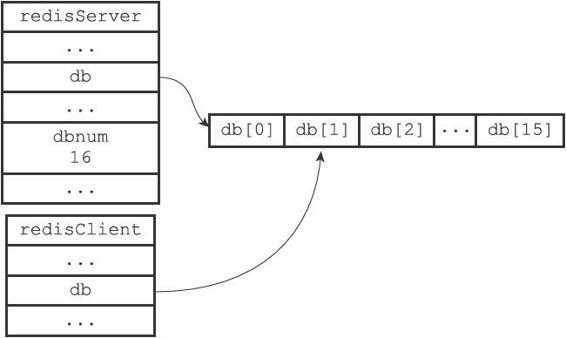
现在我们再来看看redisDb 结构,redisDb结构的dict字典保存了数据库中的所有键值对,我们将这个字典称为键空间(key space):
typedef struct redisDb {
// ...
//
数据库键空间,保存着数据库中的所有键值对
dict *dict;
// ...
} redisDb;
下面是一个例子:
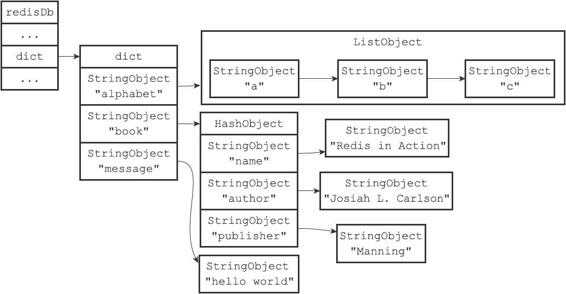
根据这个键空间,执行相关的添加、删除、更新等操作的便可以比较容易理解,我们此处也忽略不讲了。
下面我们再来介绍一下redisDb结构中的另外一个字典expires,这个字典保存了数据库中所有键的过期时间,我们称这个字典为过期字典(注意这里面只保存着键的过期时间,可不是说这个字典里面的键都是过期的):
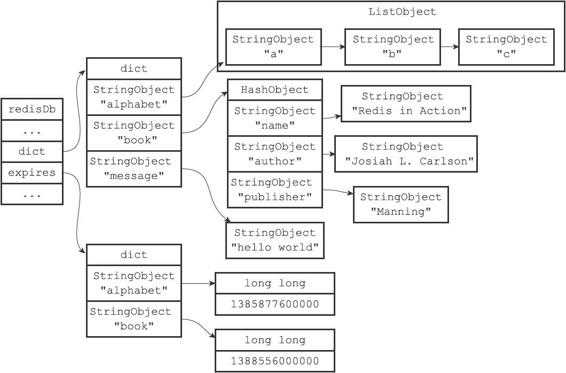
有了上面的知识我们下载便可以来看看四个命令:expire、pexpire、expireat、pexpireat的实现过程。
四个命令的使用是比较简单的:EXPIRE <key> <seconds> 如:EXPIRE book 100
PEXPIRE <key> <millionseconds>
EXPIREAT <key> <timemap>
PEXPIREAT <key> <timemap> 如:PEXPIREAT book 1388556000000(2014年1月1日零时)其实我也不知道这是怎么算出来的!!!
注意:利用PERSIST命令可以移除一个键的过期时间。
如:redis> PEXPIREAT message 1391234400000
(integer) 1
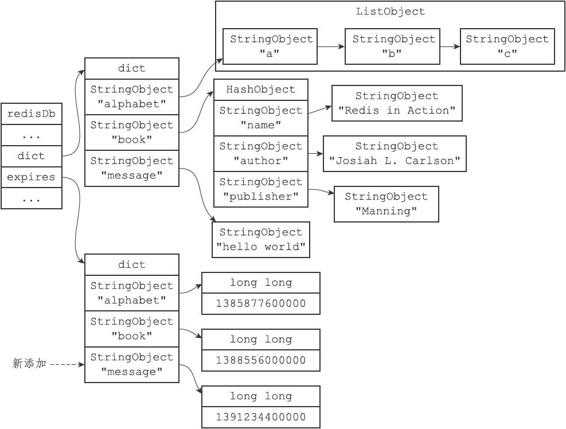
其他的命令类似。不过值得一提的是:EXPIRE、EXPIREAT、PEXPIRE全部是转换成PEXPIREAT来实现的。下面来看看每个命令的实现函数:
void expireCommand(redisClient *c) {
expireGenericCommand(c,mstime(),UNIT_SECONDS);
}
void expireatCommand(redisClient *c) {
expireGenericCommand(c,0,UNIT_SECONDS);
}
void pexpireCommand(redisClient *c) {
expireGenericCommand(c,mstime(),UNIT_MILLISECONDS);
}
void pexpireatCommand(redisClient *c) {
expireGenericCommand(c,0,UNIT_MILLISECONDS);
}
他们都调用了expireGenericCommand()函数进行实现,那我们现在就来分析一下expireGenericCommand函数是怎么实现的:
/*----------------------------------------------------------------------------- * Expires Commands *----------------------------------------------------------------------------*/ /* This is the generic command implementation for EXPIRE, PEXPIRE, EXPIREAT * and PEXPIREAT. Because the commad second argument may be relative or absolute * the "basetime" argument is used to signal what the base time is (either 0 * for *AT variants of the command, or the current time for relative expires). * * 这个函数是 EXPIRE 、 PEXPIRE 、 EXPIREAT 和 PEXPIREAT 命令的底层实现函数。 * 命令的第二个参数可能是绝对值,也可能是相对值。 * 当执行 *AT 命令时, basetime 为 0 ,在其他情况下,它保存的就是当前的绝对时间。 * * unit is either UNIT_SECONDS or UNIT_MILLISECONDS, and is only used for * the argv[2] parameter. The basetime is always specified in milliseconds. * * unit 用于指定 argv[2] (传入过期时间)的格式, * 它可以是 UNIT_SECONDS 或 UNIT_MILLISECONDS , * basetime 参数则总是毫秒格式的。 */ void expireGenericCommand(redisClient *c, long long basetime, int unit) { robj *key = c->argv[1], *param = c->argv[2]; long long when; /* unix time in milliseconds when the key will expire. */ // 取出param中的整数值或者尝试将param中的数据尽可能转换成整数值存在when中,成功返回REDIS_OK失败则返回REDIS_ERR if (getLongLongFromObjectOrReply(c, param, &when, NULL) != REDIS_OK) return; // 如果传入的过期时间是以秒为单位的,那么将它转换为毫秒 if (unit == UNIT_SECONDS) when *= 1000; when += basetime; /* No key, return zero. */ // 查询一下该键是否存在 if (lookupKeyRead(c->db,key) == NULL) { addReply(c,shared.czero); return; } /* EXPIRE with negative TTL, or EXPIREAT with a timestamp into the past * should never be executed as a DEL when load the AOF or in the context * of a slave instance. * * 在载入AOF数据时,或者服务器为附属节点时, * 即使 EXPIRE 的 TTL 为负数,或者 EXPIREAT 提供的时间戳已经过期, * 服务器也不会主动删除这个键,而是等待主节点发来显式的 DEL 命令。 * * Instead we take the other branch of the IF statement setting an expire * (possibly in the past) and wait for an explicit DEL from the master. * * 程序会继续将(一个可能已经过期的 TTL)设置为键的过期时间, * 并且等待主节点发来 DEL 命令。 */ if (when <= mstime() && !server.loading && !server.masterhost) { // when 提供的时间已经过期,服务器为主节点(注意主服务器的masterhost==NULL),并且没在载入数据 robj *aux; //删除该键 redisAssertWithInfo(c,key,dbDelete(c->db,key)); server.dirty++; /* Replicate/AOF this as an explicit DEL. */ // 传播 DEL 命令到AOF或者从服务器 aux = createStringObject("DEL",3); //修改客户端的参数数组 rewriteClientCommandVector(c,2,aux,key); decrRefCount(aux); //信号:键值已经改变了。调用touchWatchedKey(db,key) signalModifiedKey(c->db,key); //发送键空间通知和键事件通知 notifyKeyspaceEvent(REDIS_NOTIFY_GENERIC,"del",key,c->db->id); addReply(c, shared.cone); return; } else { // 设置键的过期时间 // 如果服务器为附属节点,或者服务器正在载入, // 那么这个 when 有可能已经过期的 setExpire(c->db,key,when); addReply(c,shared.cone); signalModifiedKey(c->db,key); notifyKeyspaceEvent(REDIS_NOTIFY_GENERIC,"expire",key,c->db->id); server.dirty++; return; } }
下面我将对自己在看代码时里面不太熟悉的几个函数进行说明:
getLongLongFromObjectOrReply(redisClient *c,robj *o,long long *target,const char *msg)
函数目的:尝试从对象o中取出整数值,或者尝试将对象o中的值换成整数值,并将得到的值保存在target中。同时如果转换取出/转成功的话,返回REDIS_OK,否则返回REDIS_ERR,并向客户端发送一条出错回复。
大致实现过程: getLongLongFromObjectOrReply——>getLongLongFromObject——>stroll()最后主要看看stoll函数的实现过程就OK了。
lookupKeyRead(redisDb *db,robj *key)
函数目的:为执行读取操作而取出键key在数据库中的值。并根据是否成功找到值,更新服务器中的命中和不命中信息。找搞则返回值,没找到则返回NULL
函数实现
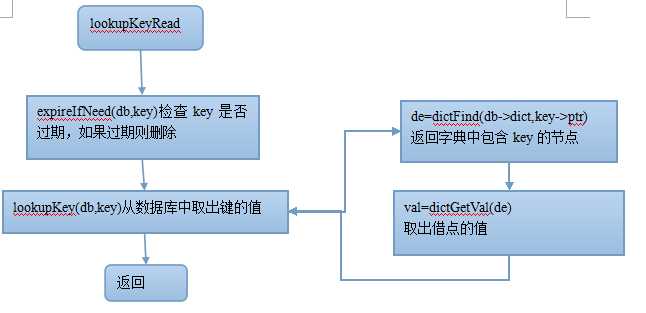
rewriteClientCommandVector(redisClient *c,int argc,...)
函数目的:修改客户端的参数数组。这其中涉及到C语言可变参数的运用,可以自行学习。
函数实现:如果理解了C语言的可变参数的大致运用的话,函数的实现过程已经大致理解了。其中需要注意的是lookupCommandOrOriginal()函数,lookupCommandOrOriginal()目的是在命令被更名之后,将更名后正确的redisCommand进行返回。
signalModifiedKey(c->db,key)键值已经改变了的信号。调用touchWatchedKey(db,key)(“触碰”一个键,如果这个键在某个客户端watch下,那这个客户端执行的EXEC时事务将失败)
notifyKeyspaceEvent(REDIS_NOTIFY_GENERIC,"del",key,c->db->id) 发送键空间通知和键事件通知(该部分知识今后会提到)
这里主要讲的Redis是怎么样设置过期键的,可以算作后续"Redis过期键的删除策略"的前篇或者说预备知识。
redis学习笔记——expire、pexpire、expireat、pexpireat的执行过程
标签:
原文地址:http://www.cnblogs.com/lukexwang/p/4719052.html